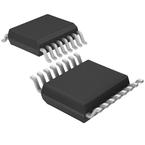●CD4029B consists of a four-stage binary or BCD-decade up/down counter with provisions for look-ahead carry in both counting modes. The inputs consist of a single CLOCK, CARRY-IN\ (CLOCK ENABLE\\\\), BINARY/DECADE, UP/DOWN, PRESET ENABLE, and four individual JAN signals, Q1, Q2, Q3, Q4 and a CARRY OUT\ signal are provided as outputs.
●A high PRESET ENABLE signal allows information on the JAM INPUTS to preset the counter to any state asynchronously with the clock. A low on each JAM line, when the PRESET-ENABLE signal is high, resets the counter to its zero count. The counter is advanced one count at the positive transition of the clock when the CARRY-IN\ and PRESET ENALBE signals are low. Advancement is inhibited when the CARRY-IN\ or PRESET ENABLE signals are high. The CARRY-OUT\ signal is normally high and goes low when the counter reaches its maximum count in the UP mode or the minimum count in the DOWN mode provided the CARRY-IN\ signal is low. The CARRY-IN\ signal in the low state can thus be considered a CLOCK ENABLE\\\\. The CARRY-IN\ terminal must be connected to VSS when not in use.
●Binary counting is accomplished when the BINARY/DECADE input is high; the counter counts in the decade mode when the BINARY/DECADE input is low. The counter counts up when the UP/DOWN input is high, and down when the UP/DOWN input is low. Multiple packages can be connected in either a parallel-clocking or a ripple-clocking arrangement as shown in Fig. 17.
●Parallel clocking provides synchronous control and hence faster response from all counting outputs. Ripple-clocking allows for longer clock input rise and fall times.
●The CD4029B-series types are supplied in 16-lead hermetic dual-in-line ceramic packages (F3A suffix), 16-lead dual-in-line plastic packages (E suffix), 16-lead small-outline packages (M, M96, MT and NSR suffixes), and 16-lead thin shrink small-outline packages (PW and PWR suffixes).

 Part 3D Model
Part 3D Model
